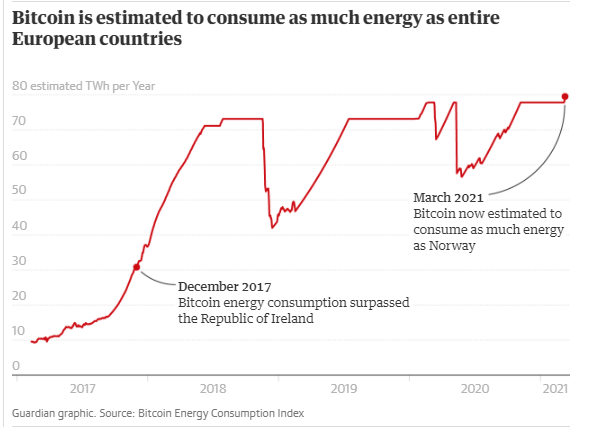Bitcoin rise could leave carbon footprint the size of London's.

Research estimates cryptocurrency will consume as much energy as all datacentres globally.
The surge in bitcoin’s price since the start of 2021 could result in the cryptocurrency having a carbon footprint the same as that of London, according to research.
Alex de Vries, a Dutch economist, created the Bitcoin Energy Consumption Index, one of the first systematic attempts to estimate the energy use of the bitcoin network. By late 2017 he estimated the network used 30 terawatt hours (TWh) a year, the same as the whole of the Republic of Ireland.
Now De Vries estimates the network uses more than twice – and possibly three times – as much energy: between 78TWh and 101TWh, or about the same as Norway.
New bitcoins are created by “mining” coins, which is done by using computers to carry out complex calculations. The more bitcoins there are, the longer it takes to mine new coin, and the more electricity is used in the process.
Roughly 60% of the costs of bitcoin mining is the price of the electricity used, de Vries estimates. The more money miners get per bitcoin, the more they will be able to spend on mining it.
However, energy use often lags behind swings in currency due to the time it takes for bitcoin miners to acquire new hardware. De Vries writes that energy use is likely to increase substantially in the short term as a result of the currency’s recent price rises, as new and established miners invest in more hardware.

By January this year the price of a bitcoin had reached $42,000. At this rate, miners would earn just over $15bn annually.
“With 60% of this income going to pay for electricity, at a price of $0.05 per kWh [kilowatt hour], the total network could consume up to 184TWh per year,” estimates De Vries.
That energy use is about the same as the 200TWh consumed by every datacentre for every other digital industry globally. The size of bitcoin’s electrical footprint means the carbon emissions are substantial.
The paper cites an assumption of 480-500g of carbon dioxide produced for every kWh consumed. “A total energy consumption of 184TWh would result in a carbon footprint of 90.2m metric tons of CO2,” De Vries writes in the journal Joule, “which is roughly comparable to the carbon emissions produced by the metropolitan area of London.”
As well as the carbon emissions of the bitcoin network, which have been widely debated as a result of the recent surge in interest, De Vries highlights other impacts of the protocol’s growth.
As well as consuming electricity, for instance, bitcoin miners need access to powerful computers, preferably including specialist chips created for mining. To produce 1m such computers, the largest provider, Bitmain, would have to use a month’s capacity of one of only two chip fabricators in the world capable of producing such high-power silicon – potentially crowding out demand from other sectors such as AI, transportation and home electronics.
In order to limit the growing footprint of the sector, De Vries suggests policymakers could follow the lead of regions that have put pressure on bitcoin miners, such as Québec in Canada, where a moratorium on new mining operations has been imposed, or Iran, which decided to confiscate mining equipment as the country suffered from outages blamed on cryptocurrency mining.
“Although bitcoin might be a decentralised currency, many aspects of the ecosystem surrounding it are not,” he writes. “Large-scale miners can easily be targeted with higher electricity rates, moratoria or, in the most extreme case, confiscation of the equipment used.
“Moreover, the supply chain of specialised bitcoin mining devices is concentrated among only a handful of companies. Manufacturers like Bitmain can be burdened with additional taxes like tobacco companies or be limited in their access to chip production.”
*whatch the video here
10 March 2021
The Guardian





